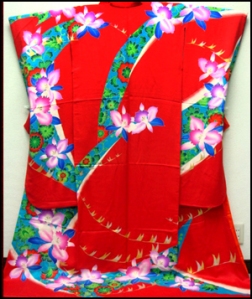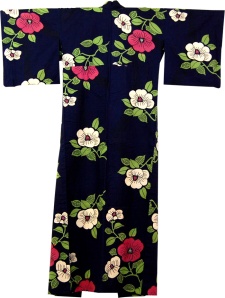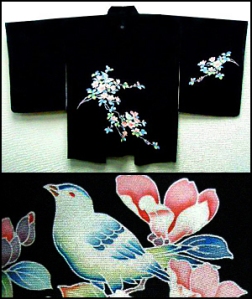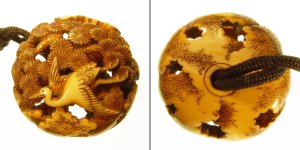Examples of different types of kimonos
Tomesode

Pattern only at the bottom, plus mon (crests) on the sleeves and shoulders, worn by married women at formal occasions. The more mon (one, three or five), the more formal the occasion it may be worn at. Black ones are called kuro tomesode and any colour other than black are called iro-tomesode (sometimes called irosode) but black is more often seen
Kuro Muji

As above but with no pattern other than the formal mon. A plain black one is a kuro tomesode, any plain colour other than black is called is an iro muji tomesode. The more mon (one, three or five), the more formal the occasion it may be worn at. This type of kimono is also worn as mofuku, which is mourning kimono, initially, during the earliest stages of mourning, with a black obi and all black accessories, gradually reducing amount of the black in the outfit as one progresses through the stages of mourning. The one shown here is a medium weight silk crepe, with a smooth silk lining but in summer a lighter weight, cooler version is worn, made of black, airy ro weave textile, with no lining
Iro Muji

Both iro muji (any plain colour except black) and kuro muji (plain black) kimonos may have a patterned texture in the weave but are just one all-over colour.
An iro muji is a less formal kimono than an iro tomesode, which is an iro muji with one, three or five mon (crests) mon. The iro muji is used for various purposes between formal and casual and, for that reason, is regarded as the basic kimono that one often wears as one’s first adult kimono
Tsukesage

Pattern at the bottom and usually on one sleeve at the back, the other at the front, but the pattern does not continue over and join up at the seams. Tsukesage are less formal than houmongi
Komon

A komon kimono. Komon have an all over repeat pattern and are known as townwear, that is, an everyday wear kimono
Houmongi

A houmongi, sometimes spelled homongi, often has a pattern around the hem and sleeve and sometimes up over the body of the kimono. On houmongi, the pattern joins up at over the seams. Houmongi means visiting dress and they are less formal than tomesode but more formal than tsukesage or komon kimonos
Odori Katamigawari

Odori means dance, so this is a traditional Japanese dancer’s kimono. Katamigawari means half and half, referring to this kimono being half one design and half another, which is more likely to be seen on an odori kimono than any other. Many odori kimonos are tsukesage, houmongi or komon in style. They are often in synthetic textiles, so they can, unlike silk, be washed regularly and they are most frequently unlined or just lower lined, to keep the dancer cooler
Furisode

Furisode kimonos are worn by unmarried women. Furisode means swinging sleeve. It is pronounced foo-ri-sody, with no stress on any of the syllables. In this description I use the term ‘long’, meaning from shoulder to base of sleeve and not from shoulder to wrist. Women’s furisode come in three types, each with progressively longer sleeves; the longer the sleeve, the more formal it is. Type 1 – Ko-Furisode: the shortest sleeved furisode, with sleeves that are around 85cm in length. “Ko” means small/short but the sleeves of ko-furisode are still very long, much moreso than standard, non-furisode (kosode) kimonos, they are just less long than the other two furisode types. One might wear a ko furisode, for example, with hakama for a graduation ceremony. Type 2 – Chu-Furisode: a furisode with sleeves that are around 100cm in length. “chu” means “medium”. Type 3 – Oh-Furisode: “oh” means big, therefore oh-furisode means big, swinging sleeves, with the longest sleeves of all the furisode type kimonos. Oh-furisode have sleeves of 114 – 115cm. It is the unmarried woman’s most formal kimono, for wear at formal, special occasions and very colourful versions of oh-furisode are worn by brides and known as kakeshita or hon-furisode. Those are women’s furisode kimonos but there is also the Jyusan-Mairi, a girl’s first furisode, which she gets at the age of thirteen
Kakeshita

A bride’s, wedding kimono, with a tiny touch of padding at the hem, as it trails slightly and the padding helps it lie properly, and furisode style sleeves. This is the last time she will wear a furisode kimono; once married, she stops wearing kimonos with furisode style, deep sleeves
Shirokakeshita

Shiro means white and the shirokakeshita is an all white wedding kimono, worn by brides during Shinto wedding ceremonies. She will wear an all white shiromuku uchikake on top of it and one of two styles of headdress, either a tsunokakushi (to cover the bride’s ‘horns of jealousy’) or a wataboushi, which is a large, hood-like hat that is the equivalent of a veil, as her face is hidden by it from side on. A wedding kimono that is a completely white is meant to show pureness of the body and mind, as well as a willingness for the bride to be “colored” with the standards of her new family. This is considered the most formal wedding costume. The bride may change into a brightly coloured uchikake kimono over her white kimono and, later, into a very colourful hikifurisode kimono (also called a hanayome furisode) in place of the white one. A Japanese bride may change her clothes about 5 times during her wedding, ending in a black tomesode kimono. Nowadays many get married in just the hikifurisode/kakeshita
Uchikake

An incredibly heavy, sumptuous kimono, worn rather like a coat, by a bride. It is worn trailing on the ground and, when she walks, the hem is held up by the bridesmaids. It is worn over a kimono and the uchikake is not worn with an obi on it. If it is a Shinto wedding ceremony, the uchikake will be all white and called a shiromoku (meaning white and pure) and worn over an all white shirokakeshita kimono
Hikizuri

This is a hikizuri kimono. It is worn for traditional dance, often by geisha and maiko, and the padded hem allows it to lie and move nicely, since it is worn trailing and delicately kicked round as the wearer turns. The one shown here would be worn by a maiko, as it is a furisode style (extremely deep, swinging sleeve); geisha wear kosode (standard depth) sleeved ones. Maiko wear these with a big tuck in each shoulder and each the sleeve, hand stitched place. These tucks are put in them because children’s kimonos are worn that way and maiko are intended to give an impression of youth and of porcelain dolls. After the maiko becomes a fully fledged geisha (also called geiko), she is intended to look sophisticated and adult, so no longer wears the ultra deep sleeves and the tucks in her kimonos
Yukata

A cotton, unlined kimono, worn at festivals in summer and as a robe at home. Nowadays a young Japanese person may not wear kimonos very often and may only hire them for special occasions, as they are so expensive to buy, but might well have one or more yukata kimonos, for summer wear, as they are much less expensive, being just cotton and unlined, are usually hand washable and require a narrower, more simply tied obi than other types of kimonos, so yukata kimonos are much more casual, easier to wear and easier to maintain
Juban

A juban kimono, full name is naga-juban. A juban is an underwear kimono, worn under the outer kimono. Only the very edge of the collar is seen, at the edge of the outer kimono’s collar, and the bottom of the juban, when the outer kimono is held up when walking. It is much shorter than an outer kimono, as it is not worn with the big fold over at the waist that outer ones are worn with
Han-Juban & Susoyke

A han-juban is a short kimono top worn as underwear, usually along with a susoyoke, a wrap skirt, both worn under the juban kimono
Montsuki

Sometimes spelled montuki. A formal, man’s kimono, unpatterned and usually black but not always. It has one three or five mon (crests) and the more mon, the more formal it is and therefore the more formal occasion it may be worn to. Garments with mon are divided into these three types: itsutsu mon (5 mon), mitsu mon (3 mon) and hitotsu mon (1 mon). If it has just one mon, it will be at the centre back of the shoulders, if three mon, they will be centre back and on the back of the sleeves and if it has five mon, there will be one on the front and back of each sleeve and one at centre back. Note: mon is crest, kamon is family crest.
Men’s kimono differ from women’s in a few ways, the most noticeable being that the sleeves on men’s are attached to the kimono body all or almost all the way down, whereas women’s kimono sleeves swing free from the body for most of their depth to allow women’s much deeper obis to sit high up and adjacent to the sleeve. Men’s obis are not only narrower but are worn lower down, especially at the front, where they are pulled down slightly low on the tummy, so, because men’s obis are fairly narrow and worn low, the sleeves do not get in the way and can therefore be more attached to the body than the sleeves on womens kimonos.
Haori

A haori is a kimono jacket, quite long, with the deep kimono sleeves, traditionally worn over the kimono and obi. A hoari is not worn with an obi or any sash around it. It can be closed edge to edge with a himo, which is a pair of front ties that are fastened to the inner edge. Women’s haori, however, also look excellent when worn with western-world clothes, such as dresses or jeans, either worn open or with a belt added. Men’s haori are usually plain on the outside, either with or without mon, but often have very decorative linings hidden inside.
Michiyuki

A square necked kimono jacket, worn over a kimono (also nice over western-world clothes). It is not worn with a sash. Usually with press studs to hold it closed
Ama Michiyuki

A square necked, kimono coat, worn over a kimono (also nice over western-world clothes), to help keep the kimono dry during rain. Their textile, often silk, is woven tightly to help repel water. Michiyuki are not worn with a sash
Uppawari

Uppawari known as house jackets. They are worn indoors, over a kimono, and fasten with an inner tie at one side and an outer tie at the other
Dochougi

A dochougi is a warm, wrap-over style jacket for wear over a kimono. They fasten with an inner tie at one side and an outer tie at the other, often the ties are braid frogging style
Neneko

A neneko (sometimes spelled nenneko) is a warm, padded jacket with kimono sleeves, for cold weather wear. Any Japanese garment tells a tale, but the neneko has quite a special one. It is a long (to the knee), thickly padded, cross-over jacket, usually with a black satin collar, and it is very large, even by Western measurements. The size is deliberate, to accommodate a mother carrying a child beneath the jacket, on her back. Though lighter, more thinly padded versions are also found, the origin of the neneko is as a blanket: nene is babytalk for nemu/nemuri, the Japanese word for sleep, and the neneko kept the child warmly nestled when mother needed to go into town
Happi

Happi are distinctly different from haori. Happi are never made of silk (usually cotton) and are not meant as kimono outerwear. Traditionally, happi are worn as work jackets or at festivals or company events to identify the wearer with a company or with a group of participants. A typical happi might have a large single character appears at the center back, a border along the hem of geometric patterning and, down each side of the front collar, a set of kanji (Japanese text) characters that name the sponsor, township, company or event that the happi coat was created for. These days, happi can be any color, but vintage versions are usually dark blue with white or red and white designs
Hanten

A hanten is a jacket, usually cotton but a little heavier than a happi, worn as work livery and at festivals
Mon

Kimonos and haori can be made formal wear by having mon (crests) on them. They can have any mon but if one is chosen that represents the family, it is called a kamon, if it is the woman’s maiden mon, it is called an onnamon. Garments have one (hitotsu mon), three (mitsu mon) or five (itsutsu mon) crests, the more mon, the more formal the occasion it may be worn at. There are different styles of mon too. In the picture above, showing three variations of icho (ginko) mon, you can see three versions of a the mon: hinata – full sun (left), kage – shadow (middle), and nakakage – mid shadow (right), which refers to how solid or faint they are. The more subtle versions are for slightly less formal occasions. There are also embroidered mon, called nui mon.















































